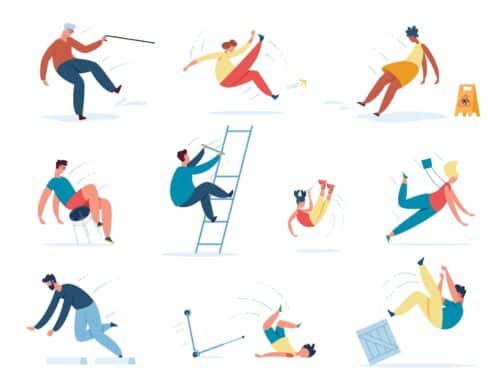First, let’s define what we are talking about because it is not what you think. Components are parts, elements, and units of a whole—not what we normally associate with risk factors for falls or other common elements that contribute to falling. However, Google has not made this same distinction between “components” and “contributing factors,” and will offer a lot of advice on how to assess and identify these fall risks no matter which you search. And we all know Dr. Google would never lie to us.
Components of a fall are exactly that: what happens when we fall. Here, we are specifically focusing on falls that take place without outside interference (i.e., no one came out of the blue and decided to take us down like they were tackling us in football, or inadvertently ran into us because they were texting). Usually, you are walking or running along without a care in the world, or maybe you are so absorbed in thought on how to bring about world peace, when suddenly—BANG! Something happens, and you find yourself on the ground, sometimes not even realizing how you got there.
In an ideal world, no one gets seriously hurt, so you would simply pick yourself up and go on your merry way. In this piece, it’s the “blank” in your mind during a fall—the moment when you’re unsure what is happening, almost like a blackout—we are going to focus on. Here are a few of the different components of a fall:

- Your Awareness – Most falls happen when we are not able to process information about our surroundings adequately. There are many ways to get this data—eyes, ears, proprioceptors (your body’s way of communicating where you are in space and time), skin, feelings… the list goes on. As we age, get injured, fail to get enough sleep, and adopt bad behaviors that contribute to messages not getting through clearly, our ability to be aware degrades. Hence, we fall.
- Agility and Reaction Speed – However, even once you are falling, it is still possible to prevent a complete fall to the ground, or worse: hitting your head on the ground. This is attainable by getting a foot underneath you and regaining your balance. Other possibilities of mitigating a fall include grabbing something to slow your fall, going down on one knee, or getting your hands out before the rest of your body hits. Your ability to act with power and speed instinctively at these moments is essential to averting major issues from falling. And yes, as we age, sit, or become more complacent in front of our devices, this component will become untrained and therefore unresponsive.
- Slowing the Fall and Boosting the Bounciness of Our Bodies – Okay, this isn’t the most scientific description, but it describes it perfectly. It’s the way our bodies absorb and then redistribute force throughout our tissues—think ligaments, tendons, muscles, and—everyone’s favorite trendy one—fascia. We need to be able to control the force (falling) and decelerate in such a way that we don’t hit the ground like a rock, instead “bouncing” and limiting the damage. There is a gradient of how much we can effectively control this deceleration. This involves things such as muscle mass and the reactivity of our receptors that contribute to how well we can react. So, if we can’t totally prevent falling, we can mitigate the damage and recover faster by not falling with our whole body weight. It must be obvious by now that external (behavior choices) and internal (genetic biomechanical predisposition) factors influence this. This is ultimately about the ability of our bodies to handle the impact caused by a fall. Slowing the fall on the way down is one key area, but the physical make-up of our bodies also comes into play.
- Ability To Get Back Up – No laughing! Some people literally cannot get down and up off the floor. Strength, flexibility, and your current health condition are big players here. You must have the strength to possibly roll over, push off the ground with hands and legs, and the ability to process information from the vestibular system to stand up and feel balanced.
- Recovery – Once you take stock of what is good and what is not so good (injured or bruised), how quickly your body can repair and heal itself will set the stage for how you process movement in the future. It can impact the likelihood of suffering another fall in a relatively short time or way further in the future.
Falls happen, and recently the number seems to be on the rise. In fact, 3 million older adults are treated in emergency departments for fall injuries each year, but even more individuals experience a fall—about 1 out of every 4 older adults. Falls are very dangerous to personal health, but they can also be costly. In 2015 alone, the total medical costs related to falls surpassed $50 billion.

There is no magic formula to put together that will eliminate falling completely. But by addressing these components, hopefully we can limit the chances of a fall occurring or limit the severity of one if it does happen. Here are a few steps to help:
- Step One: Become aware and acknowledge your risk factors: sleep, balance, flexibility, strength, medications, the amount of movement you get every day, and your happiness or mood, are just a few of the many different elements that can impact your risk of falling. This makes it a great time to get evaluated by your physicians, so you’re aware of everything going on with your body.
- Step Two: Pick one area that you can easily work on, then move on to the others. As an example, let’s focus on sleep. Getting enough sleep each night is critical for the overall health of our bodies. It also ensures we are attentive and alert throughout our day. If we are groggy or “out of it,” we may be more likely to suffer a fall.
Now, let’s go back through each of the components of a fall, and we’ll provide you with some simple ideas to get started. Remember to pick one, then when you feel that it is part of your daily routine, move on to another. There is no rush, every step you take will have an impact.
- Awareness: We have already talked about the importance of sleep as an example, but nutrition can have a big impact on nerve conduction (communication). Omega 3s, turmeric, curcumin, berries, and green tea can go a long way to help both your nerves and your brain. This is important because how our nerves function directly impacts how the parts of our bodies communicate with one another since our nerve system is how our bodies send information. An example of this is our eyes realizing we are going to fall and communicating that information to the rest of our body so we can try to catch ourselves or brace for the impact.
Mindfulness is also important, and involves taking your time instead of always rushing. Focus on what you are doing as opposed to the 10 things simultaneously flowing through your mind. Just take a few deep breaths and think about your feet growing metaphorical roots into the ground. Move with deliberation as opposed to franticness. Make it a goal to practice mindfulness one time a day for 2 weeks.
- Agility and Reaction Speed: This one you have to practice, so choose a very safe place (a corner is good, or close to a wall), especially if you are unsteady or have neurological issues. Silver Sneakers has some easy exercises that you can follow. The key is to go as fast as possible safely. If you are more functional, you can add in some more aggressive style training. Remember to start with the easy exercises, then once you are competent at the specific drill, add in new things slowly. Always be mindful of the Friday Night Rule—don’t go anywhere or do anything you can’t safely get back from.
- How Well Your Physiological Body Handles Impact: We’ve already covered sleep, nutrition, and mindfulness, so now it’s time to focus on flexibility by adding some simple daily stretching. Sleep and nutrition help the basic building blocks of our body, but we can get stuck sitting or not moving for long periods of time. A quick gentle stretching for about 5-10 minutes daily can go a long way to unlocking stiff joints and waking up our fascia, essentially providing the oil for the engine of our bodies. Think about wearing tight, stiff clothing—how well do you sit down? Now think of our new, stretchier clothing—how well do you sit down? The clothing with more give works better for sitting, right? The same is true for when we move our bodies.
- Ability To Get Back Up: Strength training is key here. Without pure strength, you might be able to use momentum to turn over or sit up, but your legs need to be flexible enough to get into the correct position and strong enough to push you off the floor. You might even need to be able to do it with one leg should an ankle or knee be injured. Just because you have held in here reading this blog, I am linking our Floor 2 Feet Exercises (again, be responsible, and check with your doctor, or if something does not feel right, stop doing it). Some exercises may not be appropriate for you, so if you need help, please reach out.
- Recovery: First, go get seen if you have suffered a fall. I know we want to just forget, but who has MRI vision? If something really hurts or you have more than a slight abrasion, it is good to get checked out by a professional. There is no way to tell what has been impacted internally. Then, of course, follow your medical professional’s advice. To improve recovery time, you should rest and eat right! Injuries require good food and plenty of rest to heal properly and quickly. Keeping well rested (7-10 hours of sleep a night) and reducing caffeinated beverages, eating more fruits, veggies, and less processed foods will give your body the upper hand in your recovery.
Lastly, don’t blame yourself. We encourage children to get back up after a fall and learn, so do the same thing yourself. This might be the best place to start with deciding what to tackle first. By going over your fall, which of the components contributed the most? If you were rushing, start building in grounding techniques. If you couldn’t react in time, then working on agility might be the ticket. This is your journey and it only applies to you. Be the captain of your ship. We are here to help navigate.
At Life Energy Foundation (LEF), we want to help you limit the likelihood and severity of falls, and do everything you can to avoid something serious. We can assist you on your journey by providing you with valuable resources and tools, as well as all the support you need. We have over 25 years of experience transforming lives and, when you are ready, we are here to help you transform yours as well. Take the first step today with our free 30 Days to Better program, which includes exercises, meditation, and other tools!

